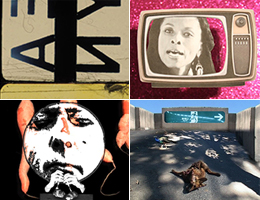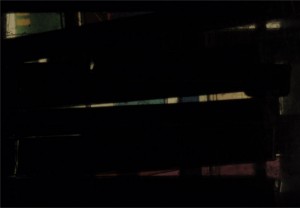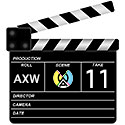GET UP STAND UP (show 11) – TRT: 32.04
Political Overtones Percolating
[toggle title=”BLACK RECTANGLE; (2013); Rhayne Vermette; 16mm; TRT: 1.30
Inspired by the slow death of Kasimir Malevich’s painting, Black Square, this film documents a tedious process of dismantling and reassembling 16 mm found footage. The film collage imitates functions of a curtain, while the recorded optical track describes the film’s subsequent destruction during its first projection.
Read more…” status=”progression_closed”]
How do you relate these very abstract film images to your other films with images of reality?
This film was initially spurred by an interest in visually representing a loosely defined interest in more cognitive or neurological phenomenons through assembling varying color gradients (something akin to synesthesia)
Is there a reason you specifically made this?
This film is the sheer invention of a maniacal impulse to simply keep busy. So I began cutting out small colored rectangles from found 16mm footage and reassembled them onto clear leader. This was quite a tedious process, yet it kept me quite occupied and content for about 7 months! And by then the collage had many layers!
As a concept, the film is hinged upon abstract artist Kazimir Malevich. He believed that the best works of art emanate from the basis of weight, speed, and direction of movement – rather than aesthetic taste. In the end, I guess this film behaves as some (absolutely literal) cinematic liberation of Malevich’s work Black Square.
[/toggle]
[toggle title=”PEN UP THE PIGS; (2014); Kelly Gallagher; TRT: 12.00
This animated film draws explicit parallels between slavery and modern day institutionalized racism and mass incarceration. Histories of radical resistance against white supremacy are explored and celebrated.
Read more…” status=”progression_closed”]
What was your creative process with Pen Up The Pigs?
I spent an extensive length of pre-production time immersing myself in the research work required of the film, which involved studying important revolutionaries who radically and imperatively resisted and struggled against white supremacy (ie: Assata Shakur, Fred Hampton, Nat Turner, etc). Ever since I learned about the historically racist beginnings of the Philadelphia Police Department (the first PPD came about from recruiting done at white supremacist youth gangs), I had been wanting to make a film connecting historical slavery to the reality of modern day slavery and the systemic racism of mass incarceration and policing. The pre-production research work did not only involve studying histories of resistance to racism, but also involved thorough image research. To acquire the paper cut-outs I used in the film, I utilized both the internet and images from books I found at local used bookstores.
Do you consider yourself more at home as an “animator” rather than any other type of filmmaker?
I consider myself as a filmmaker that straddles a few worlds – animation, experimental film, and documentary. I would say though that also being called an “animator” definitely makes sense, as all of my films include some form of animation. If anything, I suppose you could say I’m interested in handcrafted cinema – a cinema that employs tactical techniques involving handmade aspects. Pen Up the Pigs was animated entirely by hand, utilizing predominantly cut-outs and stop motion.
[/toggle]
[toggle title=”THE KITCHEN SINK; (2010); Lili White; digi; TRT: 11.24
Bombarding you with information about the Earth and our food, that straddles the physical and metaphysical stratum, presenting implications that stretch between humor and horrific reality.
Read more…” status=”progression_closed”]
What was your creative process with this film?
I wanted to bombard the viewer with information about the Earth and our food, that straddled the physical and metaphysical stratum, to present implications that stretch between humor and horrific reality. Using views inside and outside my apartment, and different fruits and vegetables, an image-collage was built from the subjects presented in a text, whose poetic form is a kind of expanding multiplicity of potentials and encounters and juxtapositions and resonances.
 All in all, The Kitchen Sink embodies the idea of plant EARTH as our sanctuary, articulating the intersection between nature and civilization; suggesting fissures between human and natural infrastructure. Its form grew in a “more, more, more” delivery that acts as an assault, like much of the violence found in human behavior.
All in all, The Kitchen Sink embodies the idea of plant EARTH as our sanctuary, articulating the intersection between nature and civilization; suggesting fissures between human and natural infrastructure. Its form grew in a “more, more, more” delivery that acts as an assault, like much of the violence found in human behavior.
A lot of the film centers on the “poppy” became a particularly interesting plant to use, as it has a myriad of functions, including that of a major addictive drug, its use in a poem about WWI, In Flanders Fields. So it acts as the force that joins together the subjects of food, war, and exploitation.
Other references include the following, gleaned from newspaper stories, the arts and scientific facts:
• The cycle of nature, and enactments of a ritualistic sort
• The risk of bees becoming extinct
• Agriculture and its relationship to charcoal and fossil fuel production
• Intricacies about famine, war, human consumption
• Details about vegetables
• Poppy crops found in oil producing regions
• Russia’s crop failure and peat fires in 2010
• Mono cropping
• Monsanto’s relation to seeds, genetic engineering, and business practices
• Dr. Rupert Sheldrake’s take on current issues of food production
• Excerpts from poems (In Flanders Fields, Oysters)
• Homage to film history images: Charlie Chaplin’s table ballet in The Goldrush and Melies’ Trip To The Moon
• The Chinese radical for “plant sprout” resembles a fork use for digging the ground and an eating implement used by Western society
• The Pleiades star cluster: used by ancient humana for planting information
• Various Goddesses, especially the Moon Goddess Diana/Artemis, who reflects light and has been used to symbolize American commerce as agriculture. Her attributes of gas flame and waterfall, used in Western art’s first installation by Marcel Duchamp, are included here.
[/toggle]
[toggle title=”UNA SPORCA VACANZA (DIRTY VACATION); (2010); Cinzia Sarto; digi; TRT: 7.00
Inside a labyrinth of cement cubes, debris by the sea, humans distracted by the rituals of vacation seem indifferent to the world surrounding them. A veiled woman is searches for a way out.
Read more…” status=”progression_closed”]
 This was my first video experiment were in the same frame I edited documentary and fiction, joining fragments of reality from different places and time and weaving the tapestry back to what I think is the essence of what I see. I placed myself in the video as the veiled woman searching a way out in a labyrinth of cement cubes, debris and water, where humans distracted by the rituals of vacation seem indifferent to the world surrounding them. The filming started when I was in the island of Pantelleria and went to look at the cemetery. Across the street from its entry the sea and the wind were roaring at a long line of cement blocks discarded on the shore. Queen Anne’s lace flowers were blooming between rocks, animal carcasses and all sort of human debris. On the other side, expensive flower arrangement were tended by hands full of sorrow, the ground was well swept.
This was my first video experiment were in the same frame I edited documentary and fiction, joining fragments of reality from different places and time and weaving the tapestry back to what I think is the essence of what I see. I placed myself in the video as the veiled woman searching a way out in a labyrinth of cement cubes, debris and water, where humans distracted by the rituals of vacation seem indifferent to the world surrounding them. The filming started when I was in the island of Pantelleria and went to look at the cemetery. Across the street from its entry the sea and the wind were roaring at a long line of cement blocks discarded on the shore. Queen Anne’s lace flowers were blooming between rocks, animal carcasses and all sort of human debris. On the other side, expensive flower arrangement were tended by hands full of sorrow, the ground was well swept.
This two way to acknowledge death were very striking at that moment and moved me to start an imaginary journey into our coexistence with decay and our unwillingness to be conscious of were we are.
If the veiled woman is a witness of event, she is also the collector of plastic waste and at the end must take upon herself the burden to carry them for a further transformation. Leaving behind a devastated landscape she will finally pronounce the sound: “maaaa…” that concludes the video. A verbal way to go back to a beginning, to start again, to leave behind all the undefined human noises covering the animal’s cry in vacation land. The video is an attempt to reveal the etymological origin of the word “vacation” from the Latin “vacare” to be vacuous, empty, free.
[/toggle]











